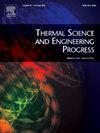Real time monitoring of motion posture using a motion accelerometer based on sensors and cellular thermodynamic analysis
IF 5.4
3区 工程技术
Q2 ENERGY & FUELS
引用次数: 0
Abstract
With the development of sports science, the monitoring technique of athletes’ physical condition is more and more demanding. Traditional monitoring methods, such as video analysis and simple accelerometer, can not meet the needs of modern sports training. In this study, a new type of motion accelerometer is designed and implemented, which can monitor and analyze the movement posture of athletes in real time. By integrating cellular thermodynamic analysis, the system not only provides traditional motion parameters such as acceleration and angular velocity, but also analyzes changes in energy metabolism at the cellular level, thus providing coaches and athletes with more comprehensive feedback on athletic performance. The motion data of athletes are collected by high precision accelerometers and gyroscopes. Then, the energy metabolism characteristics of cells in different motion states were analyzed using the principle of cell thermodynamics. Through machine learning algorithms, sensor data is combined with the results of cellular thermodynamic analysis to build a model capable of real-time monitoring of moving posture. The study also developed a user-friendly interface that enables coaches and athletes to intuitively understand the monitoring data. Through a series of experiments, the motion accelerometer developed in this study shows good performance. In the process of real-time monitoring of athletes, the system can accurately capture changes in motion posture and provide detailed information about energy metabolism through cellular thermodynamic analysis. The experimental results show that the system has significant advantages in recognizing the fatigue state of athletes, preventing sports injuries and optimizing training plans.
利用基于传感器和细胞热力学分析的运动加速度计实时监测运动姿态
随着体育科学的发展,对运动员身体状况监测技术的要求越来越高。传统的监控手段,如视频分析、简单的加速度计等,已经不能满足现代运动训练的需要。本研究设计并实现了一种新型的运动加速度计,可以实时监测和分析运动员的运动姿态。通过整合细胞热力学分析,系统不仅可以提供加速度、角速度等传统的运动参数,还可以在细胞水平上分析能量代谢的变化,从而为教练员和运动员提供更全面的运动成绩反馈。运动员的运动数据由高精度加速度计和陀螺仪采集。然后,利用细胞热力学原理分析了细胞在不同运动状态下的能量代谢特性。通过机器学习算法,将传感器数据与细胞热力学分析结果相结合,构建能够实时监测运动姿态的模型。该研究还开发了一个用户友好的界面,使教练和运动员能够直观地了解监测数据。通过一系列的实验,本研究开发的运动加速度计显示出良好的性能。在对运动员进行实时监测的过程中,系统可以准确捕捉运动姿态的变化,并通过细胞热力学分析提供详细的能量代谢信息。实验结果表明,该系统在识别运动员疲劳状态、预防运动损伤、优化训练计划等方面具有显著优势。
本文章由计算机程序翻译,如有差异,请以英文原文为准。
求助全文
约1分钟内获得全文
求助全文
来源期刊

Thermal Science and Engineering Progress
Chemical Engineering-Fluid Flow and Transfer Processes
CiteScore
7.20
自引率
10.40%
发文量
327
审稿时长
41 days
期刊介绍:
Thermal Science and Engineering Progress (TSEP) publishes original, high-quality research articles that span activities ranging from fundamental scientific research and discussion of the more controversial thermodynamic theories, to developments in thermal engineering that are in many instances examples of the way scientists and engineers are addressing the challenges facing a growing population – smart cities and global warming – maximising thermodynamic efficiencies and minimising all heat losses. It is intended that these will be of current relevance and interest to industry, academia and other practitioners. It is evident that many specialised journals in thermal and, to some extent, in fluid disciplines tend to focus on topics that can be classified as fundamental in nature, or are ‘applied’ and near-market. Thermal Science and Engineering Progress will bridge the gap between these two areas, allowing authors to make an easy choice, should they or a journal editor feel that their papers are ‘out of scope’ when considering other journals. The range of topics covered by Thermal Science and Engineering Progress addresses the rapid rate of development being made in thermal transfer processes as they affect traditional fields, and important growth in the topical research areas of aerospace, thermal biological and medical systems, electronics and nano-technologies, renewable energy systems, food production (including agriculture), and the need to minimise man-made thermal impacts on climate change. Review articles on appropriate topics for TSEP are encouraged, although until TSEP is fully established, these will be limited in number. Before submitting such articles, please contact one of the Editors, or a member of the Editorial Advisory Board with an outline of your proposal and your expertise in the area of your review.
 求助内容:
求助内容: 应助结果提醒方式:
应助结果提醒方式:


